
Views: 76051
Reviews: 11
|
[table] Pros | Lowest cost, manual focus, good meter
Cons | clunky 80s interface
Rating | 9
Price (U.S. Dollars) | 300
Years Owned | 2 [/table]
I can recommend this camera: Yes
Value, Features, Performance & Size
The lowest price of entry into Pentax medium format
Manual focus, good view finder, excellent lenses
The electronic interface and shutter logic is clunky
Super Program on Steroids!
Camera Review
As I haven't used any other modern 120 SLR, especially not the later auto focus Pentax 645's, this review is only about THIS camera as a photographic tool and object of worship :p
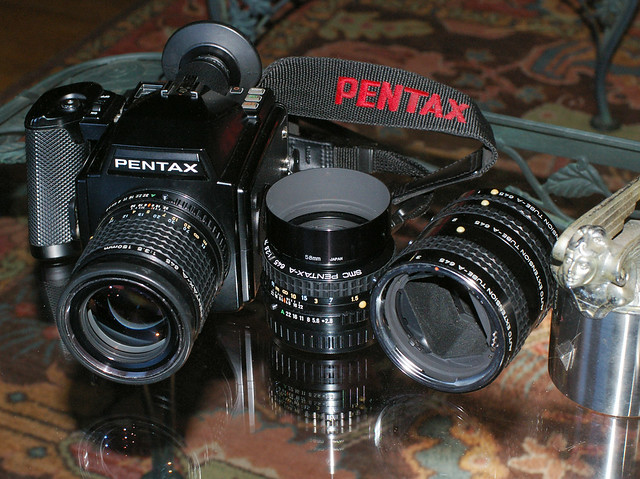 Pentax 645 by Nesster, on Flickr
The 645 with 150mm, the 75mm with Vivitar hood, the extension tube set.
The Pentax 645 shoots 6 x 4.5 pictures on 120 film - instead of the usual 16, you get 15 as the frame spacing is a bit wider than usual (the later 645N gets the full 16). This is an annoyance 2 ways - one, cheated out of 1 frame and two, makes fitting film into a standard binder holder a bit difficult. One big benefit is that there's plenty of space between frames to hold the film for scanning.
Loading the 645
You load the film into an insert that then slides and locks into the back. Pentax 645 by Nesster, on Flickr
The 645 with 150mm, the 75mm with Vivitar hood, the extension tube set.
The Pentax 645 shoots 6 x 4.5 pictures on 120 film - instead of the usual 16, you get 15 as the frame spacing is a bit wider than usual (the later 645N gets the full 16). This is an annoyance 2 ways - one, cheated out of 1 frame and two, makes fitting film into a standard binder holder a bit difficult. One big benefit is that there's plenty of space between frames to hold the film for scanning.
Loading the 645
You load the film into an insert that then slides and locks into the back.
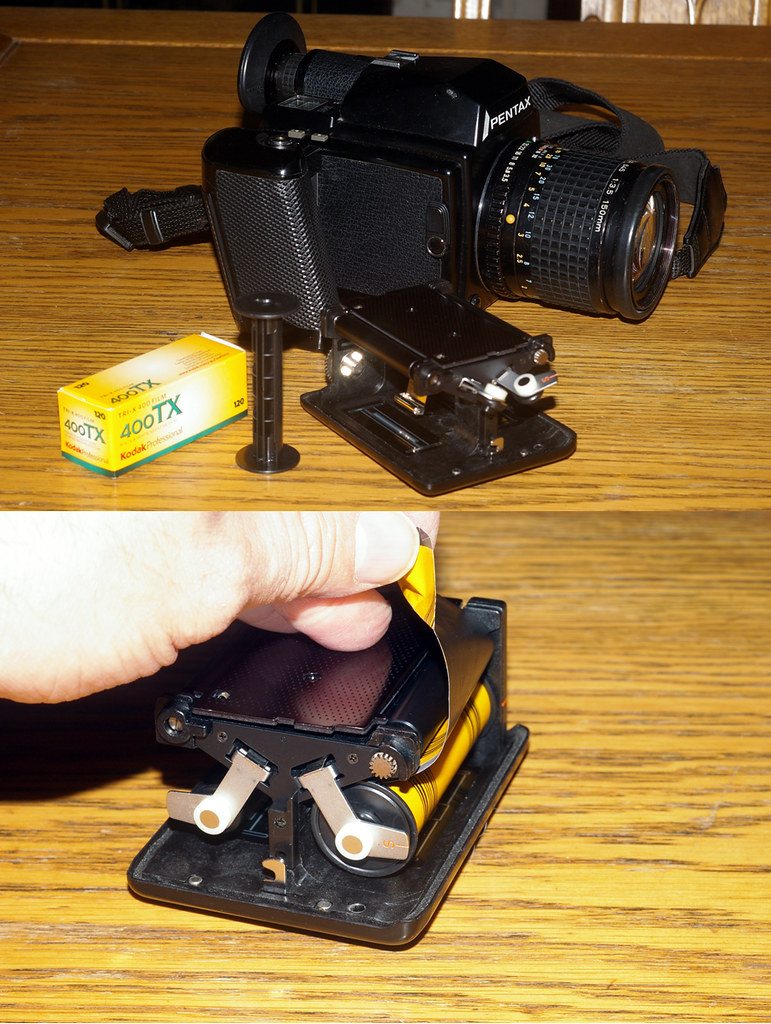 Loading a Pentax 645 A by Nesster, on Flickr
Got film, take up spool, Pentax 645 film insert
Put the roll on the side that has a picture of a roll - the other side has a picture of an empty spool
The main trick here is the film goes in 'reverse' of how one usually does it - the roll unwinds from the top with the black side UP and the colored side against the pressure plate. I've attempted to load the camera the other way, and felt dumb. No doubt I will do so again some time.
I find it easy to put the film into the take up spool slot first, then put the take up spool in the film back. Loading a Pentax 645 A by Nesster, on Flickr
Got film, take up spool, Pentax 645 film insert
Put the roll on the side that has a picture of a roll - the other side has a picture of an empty spool
The main trick here is the film goes in 'reverse' of how one usually does it - the roll unwinds from the top with the black side UP and the colored side against the pressure plate. I've attempted to load the camera the other way, and felt dumb. No doubt I will do so again some time.
I find it easy to put the film into the take up spool slot first, then put the take up spool in the film back.
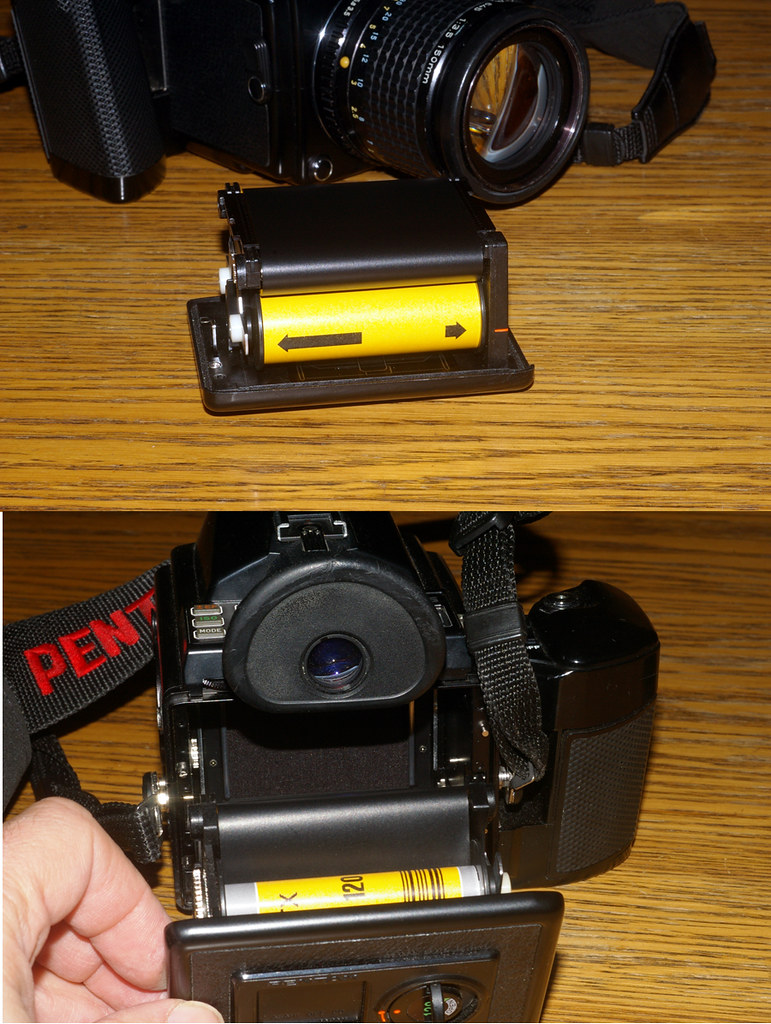 Loading a Pentax 645 B by Nesster, on Flickr
There's a metal cog wheel on the right side of the holder in the top picture, with a helpful arrow - turn the wheel in the direction of the arrow to roll film onto the take up spool till the START arrows on the film line up with the red mark on the back as in the top pic.
Put the insert in and twist the thing to lock it in place. Loading a Pentax 645 B by Nesster, on Flickr
There's a metal cog wheel on the right side of the holder in the top picture, with a helpful arrow - turn the wheel in the direction of the arrow to roll film onto the take up spool till the START arrows on the film line up with the red mark on the back as in the top pic.
Put the insert in and twist the thing to lock it in place.
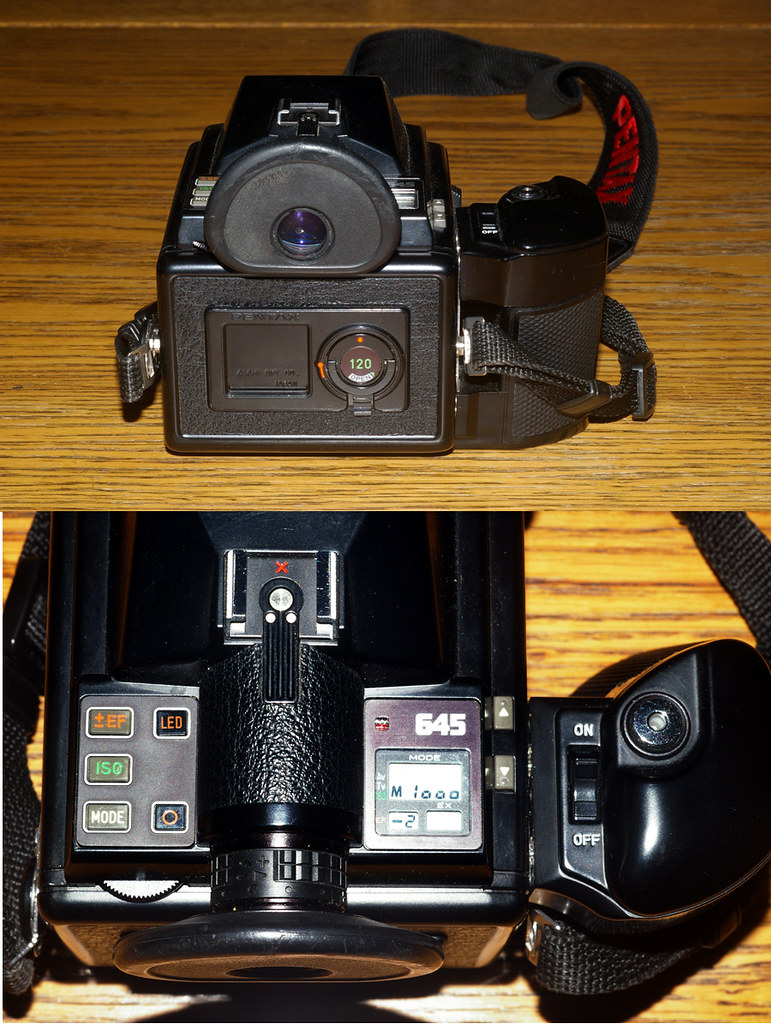 Loading a Pentax 634 C by Nesster, on Flickr
That's it, except for a rear view of the camera with insert in place.
Turn it on, and nothing happens. Turn it on with an empty holder and nothing happens. Take the empty holder out and you can get a manual 1000 speed - maybe others, but the clunky interface is hard to figure.
You have to push the shutter button, which sets off the shutter and a long wind to the first frame.
That again is something I forget sometimes.
The camera's logic is not intuitive to me - empty, you can't really test it out; you can take the back off and get into a manual mode... but it's all very 80s style. Think of the auto exposure 35mm cameras when someone had the bright idea to hard code the camera to 1000 until you reach frame 1.
But once the film is in and you convince yourself to push the shutter so it's wound to '1'... the thing comes to life. Clunky but effective is what I'd call the push button controls.
You push a button on the left and use the up/down buttons on the right to change setting.
There's a button for EV compensation, up to 3 stops in either direction, 1 stop steps.
There's an ISO selction button
There's a MODE button - when the lens aperture ring is on "A" the modes are P, Av, Tv. What? No manual mode? To get to manual, take your lens off the A... Now the MODEs available are: Av, Manually metered shutter speed, fixed 1/60, and Bulb.
Manually metered comes in 1 stop chunks only - there's no 1/2 or 1/3 fine tuning. The viewfinder indicates Ok when the meter's centered, and the +/- 3 stops in either direction. Some consider this a draw back or failing - but I say most of the time we've been conditioned to false manual accuracy with the 1/3 stop indicators. I suppose shooting slides in a studio it may make an important difference.
Note that in the auto modes, the shutter speed is set exactly rather than in the 1 stop standard increments. Ev comp as I've mentioned is in 1 stop chunks - if you want something else, change the ISO.
The metering itself, within the limits above, is excellent - predictable center weighted that gives good results. Of course as always you need to know your film's characteristics as well as the meter's. But this meter - like that on the Program Plus (and I guess the Super Pgm) - is accurate and predictable, with a wide range, which is more than I can say about the matrix metering on the K100D. I haven't done any night shots yet to be able to say how well it does in those situations; the Program Plus does very well so I predict the 645 will do so as well.
Physically the camera is deeper than a 35mm, and larger than any Pentax 35 or DSLR. But compared to some of the monster Nikon pro cameras with grips and drives, it's really about similar size, not as tall but deeper. In the hand, the camera is more nose heavy than a typical 35mm set up - I end up using my focusing hand to support the camera bottom, which is a stable configuration, and comfortable.
I've heard the 645N view finder is 'much' brighter than the 645. I don't know about that - on its own, I don't find this finder overly dark or fuzzy; the image snaps into focus pretty well, and the split prism + microprism collar are excellent in use.
Tripping the shutter is a trip - the thing KerKlunks, whirrs, gulps, cha-chings, i.e. it's pretty loud. I wouldn't pick this for a quiet event where unobtrusive photography is required.
Once the camera decides it's taken enough photos for the roll, it winds to the end, and you can take the film out. My experience with a 220 back: yes, you can modify it to do 120 by flipping a metal feeler on the insert. On my camera, what happens after exposure 15 is inconclusive - mine didn't fully believe it was a 120 holder and didn't whine its way to the end... but it didn't believe it was a 220 either. Some say using the 220 back with 120 film results in fuzzy pictures - I can't figure out how that would be, the film plane is the film plane regardless of how the pressure plate is, right? But as I don't need to, I won't repeat my experiment any time soon.
Misc notes: on my sample the diopter adjustment stays put, I see others have trouble with this. I have trouble with the slider on the K100D's diopter!
Using one of the AF***T flashes is great - there's pTTL and the combination works very very well.
It uses AA batteries for power, they last for ever, and you can use a standard threaded old fashioned plunger type of a cable release.
Picture quality? There really isn't much to say, the larger negative trumps nearly anything a 35mm camera can do. The lenses however are in 35mm territory resolution wise, so the limiting factors on image quality are how steady the camera is, how well you focused, how sharp the film is, and how good a scan (or print) you make.
Compared to more vintage 120 cameras (50s vintage Ricoh Diacord 6x6 and Voigtlander Bessa 6x9, 60s-70s vintage Yashica Mat 124G 6x6) the 645 holds its own, making up with more modern lens quality and automation what it lacks in frame size. One of the best 6x9 vintage cameras, the Kodak Medalist, may pull ahead in sheer image quality due to its excellent Ektar lens and 6x9 (i.e. double) frame size, or maybe the two are neck and neck. Obviously, all the cameras I've mentioned are more than capable of excellent results - only their applicability and areas of competence differ.
Usage - I'd rather take the Bessa or one of the TLRs when I go out for a day's walk. The 645 is just a bit heavy. But that's just wimpy me - sooner or later I'll take it for a long walk. Car based photo tripping is easy, home shooting and so on. Having the exposure automation, PTTL flash with one of the compatible (and excellent) Pentax flashes from the era, and being able to change lenses are all super benefits.
All in all, I find this a very capable camera, able to make excellent photos with and without flash. I find the clunky interface endearing most of the time... and about the only real complaint I have is common to Pentax lenses: I wish they'd allow one to focus just a bit closer! At least the smallest extension tube I find essential. Loading a Pentax 634 C by Nesster, on Flickr
That's it, except for a rear view of the camera with insert in place.
Turn it on, and nothing happens. Turn it on with an empty holder and nothing happens. Take the empty holder out and you can get a manual 1000 speed - maybe others, but the clunky interface is hard to figure.
You have to push the shutter button, which sets off the shutter and a long wind to the first frame.
That again is something I forget sometimes.
The camera's logic is not intuitive to me - empty, you can't really test it out; you can take the back off and get into a manual mode... but it's all very 80s style. Think of the auto exposure 35mm cameras when someone had the bright idea to hard code the camera to 1000 until you reach frame 1.
But once the film is in and you convince yourself to push the shutter so it's wound to '1'... the thing comes to life. Clunky but effective is what I'd call the push button controls.
You push a button on the left and use the up/down buttons on the right to change setting.
There's a button for EV compensation, up to 3 stops in either direction, 1 stop steps.
There's an ISO selction button
There's a MODE button - when the lens aperture ring is on "A" the modes are P, Av, Tv. What? No manual mode? To get to manual, take your lens off the A... Now the MODEs available are: Av, Manually metered shutter speed, fixed 1/60, and Bulb.
Manually metered comes in 1 stop chunks only - there's no 1/2 or 1/3 fine tuning. The viewfinder indicates Ok when the meter's centered, and the +/- 3 stops in either direction. Some consider this a draw back or failing - but I say most of the time we've been conditioned to false manual accuracy with the 1/3 stop indicators. I suppose shooting slides in a studio it may make an important difference.
Note that in the auto modes, the shutter speed is set exactly rather than in the 1 stop standard increments. Ev comp as I've mentioned is in 1 stop chunks - if you want something else, change the ISO.
The metering itself, within the limits above, is excellent - predictable center weighted that gives good results. Of course as always you need to know your film's characteristics as well as the meter's. But this meter - like that on the Program Plus (and I guess the Super Pgm) - is accurate and predictable, with a wide range, which is more than I can say about the matrix metering on the K100D. I haven't done any night shots yet to be able to say how well it does in those situations; the Program Plus does very well so I predict the 645 will do so as well.
Physically the camera is deeper than a 35mm, and larger than any Pentax 35 or DSLR. But compared to some of the monster Nikon pro cameras with grips and drives, it's really about similar size, not as tall but deeper. In the hand, the camera is more nose heavy than a typical 35mm set up - I end up using my focusing hand to support the camera bottom, which is a stable configuration, and comfortable.
I've heard the 645N view finder is 'much' brighter than the 645. I don't know about that - on its own, I don't find this finder overly dark or fuzzy; the image snaps into focus pretty well, and the split prism + microprism collar are excellent in use.
Tripping the shutter is a trip - the thing KerKlunks, whirrs, gulps, cha-chings, i.e. it's pretty loud. I wouldn't pick this for a quiet event where unobtrusive photography is required.
Once the camera decides it's taken enough photos for the roll, it winds to the end, and you can take the film out. My experience with a 220 back: yes, you can modify it to do 120 by flipping a metal feeler on the insert. On my camera, what happens after exposure 15 is inconclusive - mine didn't fully believe it was a 120 holder and didn't whine its way to the end... but it didn't believe it was a 220 either. Some say using the 220 back with 120 film results in fuzzy pictures - I can't figure out how that would be, the film plane is the film plane regardless of how the pressure plate is, right? But as I don't need to, I won't repeat my experiment any time soon.
Misc notes: on my sample the diopter adjustment stays put, I see others have trouble with this. I have trouble with the slider on the K100D's diopter!
Using one of the AF***T flashes is great - there's pTTL and the combination works very very well.
It uses AA batteries for power, they last for ever, and you can use a standard threaded old fashioned plunger type of a cable release.
Picture quality? There really isn't much to say, the larger negative trumps nearly anything a 35mm camera can do. The lenses however are in 35mm territory resolution wise, so the limiting factors on image quality are how steady the camera is, how well you focused, how sharp the film is, and how good a scan (or print) you make.
Compared to more vintage 120 cameras (50s vintage Ricoh Diacord 6x6 and Voigtlander Bessa 6x9, 60s-70s vintage Yashica Mat 124G 6x6) the 645 holds its own, making up with more modern lens quality and automation what it lacks in frame size. One of the best 6x9 vintage cameras, the Kodak Medalist, may pull ahead in sheer image quality due to its excellent Ektar lens and 6x9 (i.e. double) frame size, or maybe the two are neck and neck. Obviously, all the cameras I've mentioned are more than capable of excellent results - only their applicability and areas of competence differ.
Usage - I'd rather take the Bessa or one of the TLRs when I go out for a day's walk. The 645 is just a bit heavy. But that's just wimpy me - sooner or later I'll take it for a long walk. Car based photo tripping is easy, home shooting and so on. Having the exposure automation, PTTL flash with one of the compatible (and excellent) Pentax flashes from the era, and being able to change lenses are all super benefits.
All in all, I find this a very capable camera, able to make excellent photos with and without flash. I find the clunky interface endearing most of the time... and about the only real complaint I have is common to Pentax lenses: I wish they'd allow one to focus just a bit closer! At least the smallest extension tube I find essential.
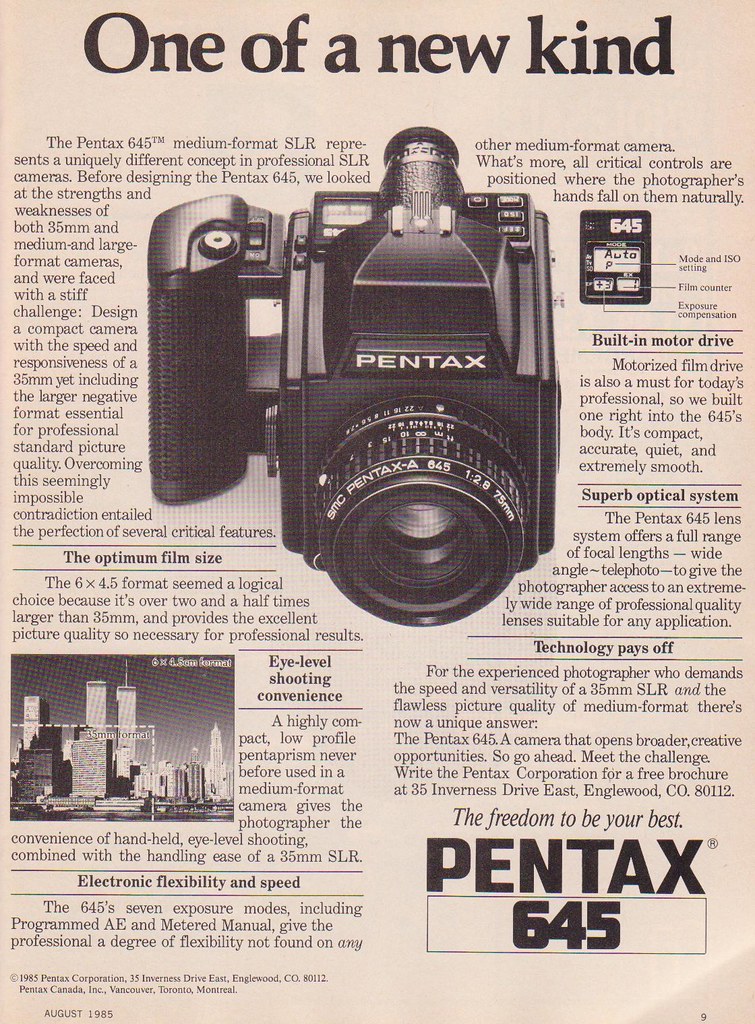 One of a new kind: Pentax 645 by Nesster, on Flickr
**** Addendum 11/1/2011: My camera's AA batteries finally went low. THERE IS NO BATTERY INDICATOR on the camera. The first symptom of batteries running low is that the film transport starts to misbehave: either it doesn't whirr to the next frame, or does so inaccurately, or it can't manage to whirr to the next frame at all. The LCD indicators etc are still fine as they consume less juice.
When this happens, please resist the urge to open up the back! Chances are you did load the film OK, if it ever advanced to "1" at all. Go to your stash of AA's and replace the batteries, then see if that solved the issue.
It happens seldom enough that one may forget; and the first time it happens is not so happy.
Also, I have posted a contemporary Modern Photography review of the 645 here:
https://www.pentaxforums.com/forums/pentax-medium-format-645-6x7-645d/155330-modern-photography-tests-pentax-645-1985-a.html#post1613765 One of a new kind: Pentax 645 by Nesster, on Flickr
**** Addendum 11/1/2011: My camera's AA batteries finally went low. THERE IS NO BATTERY INDICATOR on the camera. The first symptom of batteries running low is that the film transport starts to misbehave: either it doesn't whirr to the next frame, or does so inaccurately, or it can't manage to whirr to the next frame at all. The LCD indicators etc are still fine as they consume less juice.
When this happens, please resist the urge to open up the back! Chances are you did load the film OK, if it ever advanced to "1" at all. Go to your stash of AA's and replace the batteries, then see if that solved the issue.
It happens seldom enough that one may forget; and the first time it happens is not so happy.
Also, I have posted a contemporary Modern Photography review of the 645 here:
https://www.pentaxforums.com/forums/pentax-medium-format-645-6x7-645d/155330-modern-photography-tests-pentax-645-1985-a.html#post1613765 | |